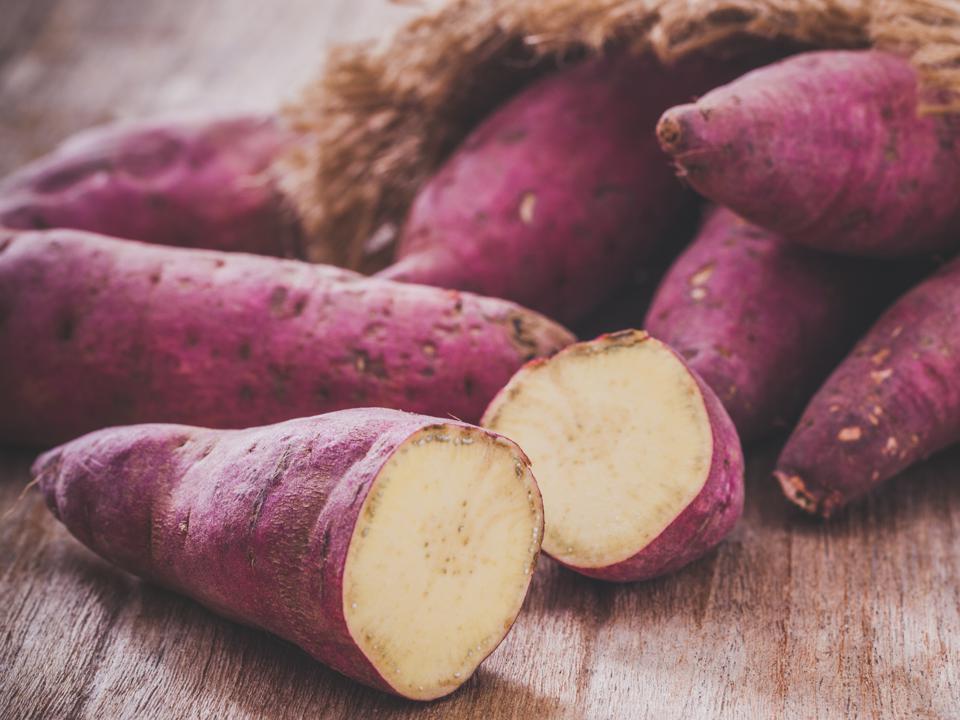Forbes – Originally domesticated in Latin America more than 5,000 years ago, sweet potatoes currently grow in more developing countries than any other root crop, with up to a million tonnes produced in the Caribbean per year (FAOSTAT, 2016).
Identified as the fifth most important food crop in the developing world, and one of the main crops identified for Caribbean food security, sweet potatoes produce more biomass and nutrients per hectare than any other food crop.
This superfood has immense potential to fuel Caribbean development, not only in the alleviation of food insecurity and as a nutrition crop but also from the perspective of climate adaptation and mitigation, and as a driver of economic development.
Sweet potatoes are able to grow in a variety of settings and conditions. Small and subsistence farmers have the ability to produce the crop on small parcels of marginal or inferior land without pricey inputs such as labour, fertilizers and irrigation— allowing rural communities to take charge of their own production and food security.
As sweet potatoes have gained importance as a strategic crop, many production systems have transitioned to larger, commercial-sized acreages.
The largest producers in the region are currently Jamaica (43,188 tonnes in 2019), Haiti (42,002 tonnes in 2019), St Vincent and the Grenadines (2,500 tonnes in 2019), Dominica (2,385 tonnes in 2019) and Barbados (2,093 tonnes in 2019). (FAOSTAT) Sweet potato is conducive to sustainable growth, producing high yields per unit area of land with limited impact to air, water, land, soil or forests and can grow at both high and low altitudes, with a smaller environmental footprint than other staple crops.
It easily adapts to harsh environmental conditions— also making it a climate-resilient crop— and provides environmental benefits with respect to climate change mitigation and soil health.
As a perennial, or crop that lives for 3 or more years, the sweet potato crop does not need frequent replanting or reseeding which means that it is not damaging to the soil and can grow in extremely dry conditions.
In 2020, Dr Angela Alleyne, Senior Lecturer in Biochemistry at the University of the West Indies (UWI), conducted research on 15 varieties of sweet potato across five Caribbean countries, and identified several drought-tolerant varieties under commercial production in Dominica (“SDPW-01” and “SRDY-DOM”), Grenada (“Cricket Gill” and “Hucky”), Jamaica (“Ganja” and “Fire on Land”), and St. Lucia (“SSLYY”). These climate resilient varieties are an excellent choice for production as the region continues to experience more severe dry seasons.
Recently, the “Up-lifter” variety of sweet potato, in Jamaica, was also identified for its role in soil protection. Farmers have reported that within 10 weeks of planting, the crop covers the soil, preventing erosion.
Sweet potatoes present an excellent opportunity for food waste reduction— most parts of the plant are edible, including leaves, roots, and vines. Regional processors have reported that between 30 and 50 per cent of production typically gets thrown away in processing, but with some creativity, this is avoidable.
An effective role for the underutilized parts of the sweet potato plant, for example, is in animal feed. Not only is sweet potato a nutritious option for animals, but studies have suggested that animals fed on high protein sweet potato vines produce less methane gas, helping to reduce the 220 pounds of harmful emissions that a single cow produces each year.
From a nutritional perspective, sweet potato is a super food. Sweet potatoes are rich in carbohydrates, micronutrients, antioxidants and fibre and produce more edible energy per hectare per day than wheat, rice or cassava.
The leaves and shoots are good sources of vitamins A, C, and B (Riboflavin) and the flesh is one of the best food sources of beta carotene, a powerful antioxidant that the body can convert to vitamin A. Just 125 grams of sweet potato can meet the daily Vitamin A requirement of a preschool child, thus protecting that child from stunting and night blindness.
Globally rising food prices and reduced availability of staples such as cereals and grains has led the governments of the region to establish food and nutrition security goals to reduce reliance on imports, through import substitution with traditional staples, such as sweet potato.
Sweet potato’s role as a strategic food crop was highlighted in Grenada, during COVID-19, when the population was at its most vulnerable.
“What we have seen here at CARDI is a massive increase by farmers and home gardeners in sweet potato production, and this took place as a result of COVID-19,” explained Reginald Andall, the Caribbean Agricultural Research and Development Institute (CARDI) representative to Grenada.
“People have taken it into their own hands to try to increase their local food production, and this is the first year in many years that we have seen such a great demand for sweet potato planting material.”
According to Dr Greg Robin, Jamaica country representative of CARDI, there is an under-tapped income opportunity for regional producers, in that the Caribbean imported approximately $57.4 million worth of sweet potatoes in 2019. Trinidad and Tobago imported 393 tonnes of sweet potatoes during that year alone.
And at a consumer level, not only is sweet potato nutritious and delicious, but it is also affordable. In June 2014, a research team obtained the average prices and nutritional benefits of one hundred and fifty eight commonly consumed foods across six parishes in Jamaica, after which they were ranked. Sweet potato was found to be the cheapest food to make it into the top ten.
In the region, the root vegetable has been typically used in its primary state, either baked, boiled or fried, as an accompaniment to a protein, or as a key ingredient in traditional dishes such as sweet potato pie or Ducana, a dumpling or pudding made from sweet potato, grated coconut, sugar, flour, coconut milk, and/or water, raisins, ginger, grated nutmeg, salt and vanilla extract.
“Sweet potato is the candy vegetable,” says Barbadian Chef, Jason Howard. “It’s one of my favourite vegetables to cook with as it has the perfect texture and taste and is very versatile when transformed into a powder or liquid form.”

Due to a growing health consciousness among Caribbean consumers there has been an emerging market for value added products made with sweet potato. In recent years, agri-processers have begun to convert the crop into starch, flour, alcohol, confectionery, snacks, purees and thickening agents, nutraceuticals, animal feed, and other value added products.
In September 2020, it was announced that CARDI would be collaborating with the Food and Agriculture Organization (FAO) to set up a solar-energy drying project to produce flour from sweet potato in Grenada. That project is ongoing.
In September 2020, Onel Williams, owner of food services company Essential Goods and Services Trading Ltd, producers of the Nella’s Foods JA brand, launched Nella’s Tendaronis, Jamaica’s first sweet potato pasta.
In Barbados, agri-food processor Carmeta’s transforms the succulent Bajan sweet potato into a variety of value added options including Carmeta’s Sweet Potato Flour, Carmeta’s Marion Sweet Potato Cookies and Carmeta’s Sweet Potato ‘n Spice Sorbet.

Starch and flour processing from sweet potato has provided the opportunity to create new economic and employment activities for rural households, while adding nutritional value to local food systems. Repositioning sweet potato production and its potential for value-added products will optimize its food systems benefits to the region.
Sweet potato is the Caribbean’s regenerative giant. It is adaptable to a wide range of uses, from food security crop to cash crop, from human nutrition to animal feed, from fresh food to processed products and as a strategic regenerative crop for the community, the economy and the environment.




